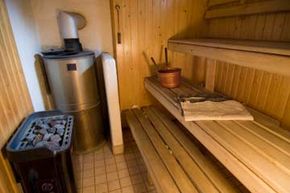Sauna Construction: The Science of Sweat
There you are in the sauna, heat permeating your body. You inhale and catch a hint of fresh sweat beneath the rich aroma of steamed cedar and maybe a few traditional herbs. Your mind and body drift into a deeply relaxed state, but hold on. What if you want things a little hotter?
Look for that bucket and ladle we mentioned. The kiuas heats the rocks and the rocks heat the air inside the sauna. To raise the temperature any higher, all you have to do is pour a little water from the bucket on the rocks. The water will instantly burst into steam with a sharp cracking sound and maybe a hiss. You've now added humidity to the air in the sauna, elevating the apparent heat. The Finnish term for this hot sauna vapor is löyly.
Advertisement
Sauna construction runs the gamut, from backyard hovels in the woods to just about the ritziest spa faculties imaginable. Maximum occupancy ranges from a single bather to the entire Swiss men's national ice hockey team. In Finland, where saunas are integral to daily life, it's customary to bring portable, folding saunas on camping trips. The soldier's life isn't complete without one either. When the Finnish army sent troops to help restore war-torn Kosovo, the army made sure to construct 20 saunas for its 800-troop contingency [source: Gray]. Even Finnish prisons offer sauna privileges to inmates.
The traditional sauna has remained unchanged for centuries, but if you're itching for something more high-tech, you can always disrobe for an infrared sauna. The aim is still the same: transfer heat to the human body, only instead of depending on hot stones, it directly heats bathers with infrared light. Proponents of this technology argue that infrared provides a superior sauna experience since the infrared radiation penetrates deeper into bone and muscle tissue. They also argue that a session of infrared imparts all the beneficial aspects of sunlight, only without all the blisters and skin cancer.
But let's get back to the traditional sauna and throw a little more water on the kiuas, shall we? What does all this sweating do for your health?
